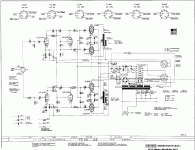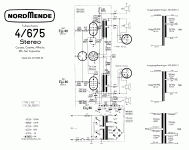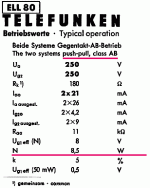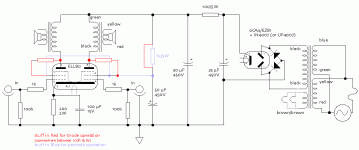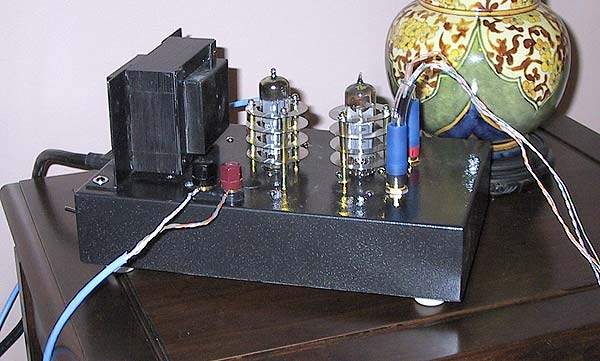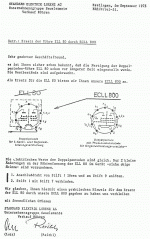50w would take an awful lot of ELL80 in parallel. An ELL80 can be thot of as 2 EL93 in one envelope.
An SE amp good for about 3W by Nordmende:

A Push-Pull Grundig, might make 10W:
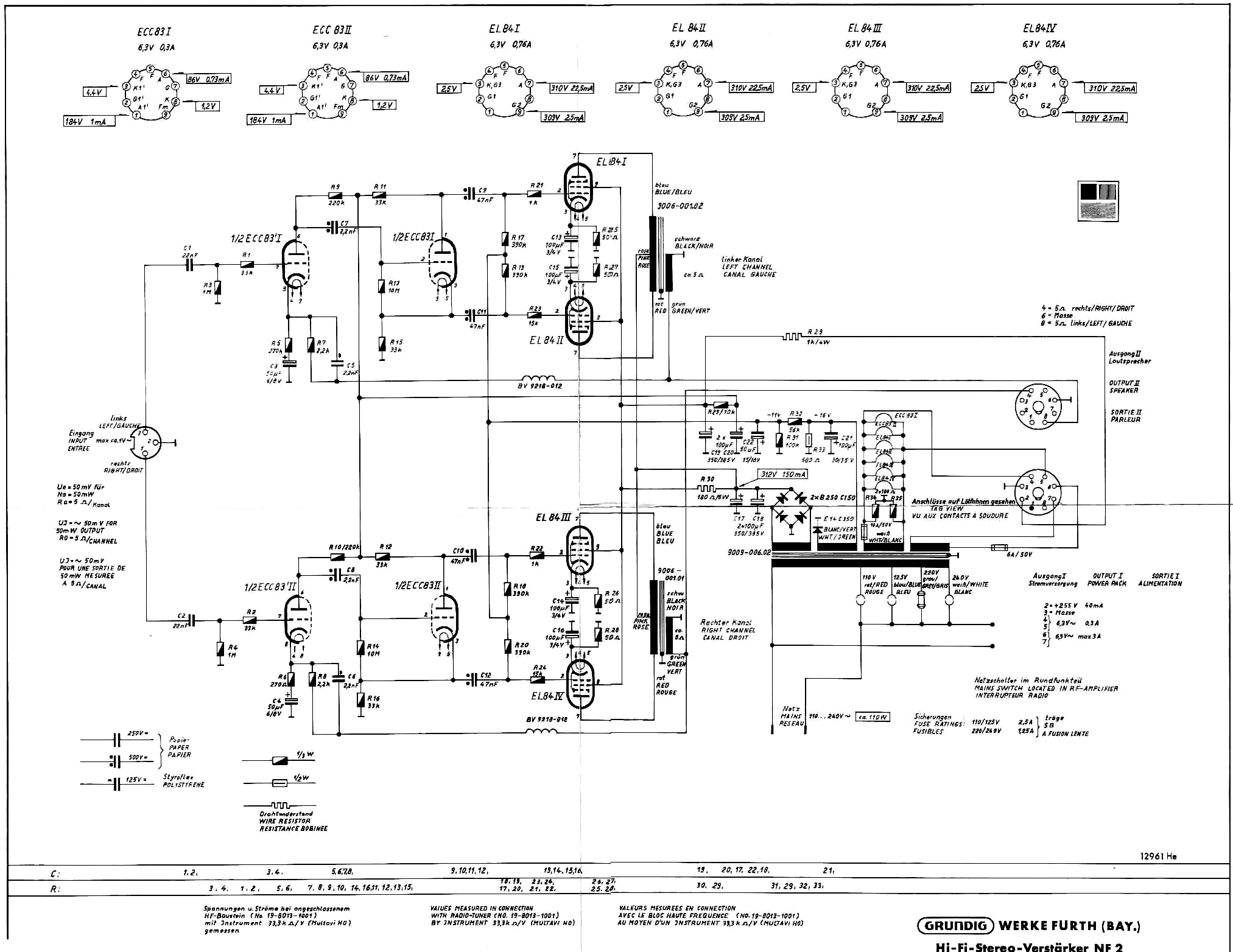
dave
An SE amp good for about 3W by Nordmende:
A Push-Pull Grundig, might make 10W:
dave
Attachments
> ell80 as power tube. ....for a 50 watt
Datasheet says ELL80 can do 8.5 Watts one bottle push-pull.
50W means six bottles working into 1.8K (an uncommon load).
This tube is VERY rare.
I'm seeing prices of $80 and no stock in hand.
Six bottles is $480. For stereo, call it a thousand bucks with shipping.
Unknown how long it will take to source twelve good ELL80.
Datasheet says ELL80 can do 8.5 Watts one bottle push-pull.
50W means six bottles working into 1.8K (an uncommon load).
This tube is VERY rare.
I'm seeing prices of $80 and no stock in hand.
Six bottles is $480. For stereo, call it a thousand bucks with shipping.
Unknown how long it will take to source twelve good ELL80.
Attachments
The pentode in the 6T10 and 6AD10 are virtually identical to the ELL80.
The 6T10 is available at $1 on the Dollar Days list at ESRC. Same gm, same g2/g1 Mu, same curves, more Watts (10).
What you get with all these non beam type power pentodes is a dose of 3rd harmonic from the rounded plate curve knees. Designed to remove 2nd harmonic in SE audio output mode. Similar to 6BQ5 in that respect.
https://frank.pocnet.net/sheets/123/6/6AD10A.pdf
https://frank.pocnet.net/sheets/123/6/6T10.pdf
https://frank.pocnet.net/sheets/124/e/ELL80.pdf
The 6T10 is available at $1 on the Dollar Days list at ESRC. Same gm, same g2/g1 Mu, same curves, more Watts (10).
What you get with all these non beam type power pentodes is a dose of 3rd harmonic from the rounded plate curve knees. Designed to remove 2nd harmonic in SE audio output mode. Similar to 6BQ5 in that respect.
https://frank.pocnet.net/sheets/123/6/6AD10A.pdf
https://frank.pocnet.net/sheets/123/6/6T10.pdf
https://frank.pocnet.net/sheets/124/e/ELL80.pdf
Instead of rare ELL80 I would consider to use quite similar QQE03/12 (6360, ГУ17).
It can produce some 10...12 W / tube as PP. These are still cheap at Ebay.
Lot of 4 Tesla QQE03/12 Tubes = GU17 / 6360 / RS1029 / CV2798 NOS | eBay
Specs:
http://www.mif.pg.gda.pl/homepages/frank/sheets/077/6/6360.pdf
It can produce some 10...12 W / tube as PP. These are still cheap at Ebay.
Lot of 4 Tesla QQE03/12 Tubes = GU17 / 6360 / RS1029 / CV2798 NOS | eBay
Specs:
http://www.mif.pg.gda.pl/homepages/frank/sheets/077/6/6360.pdf
The ELL80 was a popular tube on early german stereo receivers because it allowed to fit a stereo design in the same footprint and cost of earlier mono designs. There are no 50w amplifers based on ELL80 because it is a small tube totally unsuited for this job. QQE03/12 is indeed a popular substitute for ELL80, but socket connections are different and electrical parameters aren't the same. A perfect substitute on most instances is the ECLL800. It can be exchanged for the ELL80 with a single rewire of pin 1 at the socket or a tube adapter. The catch is that on the ECLL800 both screen grids are tied toghether, while on ELL80 are separate. There is even a official Lorenz technical note dated september 1975 with the wiring details. Today a NOS ECLL800 has unfortunately almost the same cost of the ELL80.
Most ECLL800 amplifiers are push-pull because the special unit-gain phase inverter triode of the ECLL800 made this arrangement very simple and effective. The best example in english language has been published by Practical Wireless in the march 1964 issue at page 1024. The full issue is on the American Radio History website.
I have several German ECLL800 based radios on my collection and also a small stash of NOS ECLL800 tubes, and sometimes I feel the urge to build a ECLL800 amplifier. The issue with the recreation of ECLL800 based amplifiers is the weird output transformer needed. Back at the time there were two kind of transformers for ECLL800, almost identical for any manufacturer. Maybe the transformer design was a Lorenz specification, but I was unable to trace a source. The transformer for single ended confguration was usually fitted on standard 3w+3w receivers and portable tape recorders. Primary impedence is 10K, secondary 4 ohms. The transformer for push-pull operation is rated 9W (class AB), it does have the same size and 11k a-a impedence. There is a separate winding for the NFB and it is usually gapped. I believe that the air gap was there to compensate for any mismatch between sections of the tube, or maybe is simply a cost-cutting measure to reuse the same core of the vastly more popular SE transformer. Both vintage transformer types are readily available on the usual web sites, but the low frequency response is limited because they were paired with bookshelf-style speakers. For a modern day Hi-Fi experience a bigger transformer would be needed, but then the cost of the build will skyrocket and better tubes would be the logical choice.
Altough a parallel ELL80 push pull is higly impractical, maybe a QQE03/12 parallel push pull is possible, but I don't know what primary impedence would be optimal and if the tube will actually sounds good.
Most ECLL800 amplifiers are push-pull because the special unit-gain phase inverter triode of the ECLL800 made this arrangement very simple and effective. The best example in english language has been published by Practical Wireless in the march 1964 issue at page 1024. The full issue is on the American Radio History website.
I have several German ECLL800 based radios on my collection and also a small stash of NOS ECLL800 tubes, and sometimes I feel the urge to build a ECLL800 amplifier. The issue with the recreation of ECLL800 based amplifiers is the weird output transformer needed. Back at the time there were two kind of transformers for ECLL800, almost identical for any manufacturer. Maybe the transformer design was a Lorenz specification, but I was unable to trace a source. The transformer for single ended confguration was usually fitted on standard 3w+3w receivers and portable tape recorders. Primary impedence is 10K, secondary 4 ohms. The transformer for push-pull operation is rated 9W (class AB), it does have the same size and 11k a-a impedence. There is a separate winding for the NFB and it is usually gapped. I believe that the air gap was there to compensate for any mismatch between sections of the tube, or maybe is simply a cost-cutting measure to reuse the same core of the vastly more popular SE transformer. Both vintage transformer types are readily available on the usual web sites, but the low frequency response is limited because they were paired with bookshelf-style speakers. For a modern day Hi-Fi experience a bigger transformer would be needed, but then the cost of the build will skyrocket and better tubes would be the logical choice.
Altough a parallel ELL80 push pull is higly impractical, maybe a QQE03/12 parallel push pull is possible, but I don't know what primary impedence would be optimal and if the tube will actually sounds good.
Attachments
The QE03/12 6360 tube is a beam tetrode with square knees, unlike the ELL80, which is an ordinary pentode with rounded knees. They aren't going to sound the same.
The 6T10, 6AD10 and also 6AL11 and even 6T9 (all have the same pentode with rounded knees like the ELL80) are virtually identical to the ELL80 pentode, except higher power. Same Ri, same gm, same g2/g1 Mu, even the same distortion in class A. Being 10 Watt (12 W for 6T9) these are spec'd at 5K Ohm for the OT for class A SE (4.2 Watts output). Which would then be about a 6.6K or 8K Ohm OT in class AB P-P (14 Watts output for a pair), a common OT size. And $1 each (6T10 or 6AL11)
4 pairs could then get one about 56 Watts output if that's making any sense.
https://frank.pocnet.net/sheets/049/6/6AL11.pdf
https://frank.pocnet.net/sheets/123/6/6AD10A.pdf
https://frank.pocnet.net/sheets/123/6/6T10.pdf
https://frank.pocnet.net/sheets/201/6/6T9.pdf
https://frank.pocnet.net/sheets/124/e/ELL80.pdf
.
The 6T10, 6AD10 and also 6AL11 and even 6T9 (all have the same pentode with rounded knees like the ELL80) are virtually identical to the ELL80 pentode, except higher power. Same Ri, same gm, same g2/g1 Mu, even the same distortion in class A. Being 10 Watt (12 W for 6T9) these are spec'd at 5K Ohm for the OT for class A SE (4.2 Watts output). Which would then be about a 6.6K or 8K Ohm OT in class AB P-P (14 Watts output for a pair), a common OT size. And $1 each (6T10 or 6AL11)
4 pairs could then get one about 56 Watts output if that's making any sense.
https://frank.pocnet.net/sheets/049/6/6AL11.pdf
https://frank.pocnet.net/sheets/123/6/6AD10A.pdf
https://frank.pocnet.net/sheets/123/6/6T10.pdf
https://frank.pocnet.net/sheets/201/6/6T9.pdf
https://frank.pocnet.net/sheets/124/e/ELL80.pdf
.
Last edited:
6J10 and 6Z10 too.
The 6J10 pentode is a similar beam pentode, which may have a sharper knee than the others.
The 6Z10 has an even MORE rounded plate curve knee than the others.
More rounded than the ELL80. If you like that rounding effect on the sound, here's your tube.
https://frank.pocnet.net/sheets/049/6/6J10.pdf
https://frank.pocnet.net/sheets/123/6/6Z10.pdf
The 6J10 pentode is a similar beam pentode, which may have a sharper knee than the others.
The 6Z10 has an even MORE rounded plate curve knee than the others.
More rounded than the ELL80. If you like that rounding effect on the sound, here's your tube.
https://frank.pocnet.net/sheets/049/6/6J10.pdf
https://frank.pocnet.net/sheets/123/6/6Z10.pdf
Last edited:
After printing out the pentode plate curves, I found that the 6J10 pentode is the same as the pentode in 6T10, 6AD10, 6AL11, 6T9 (and ELL80) while the 6Z10 is the oddball with super rounded curves.
Since 6J10 and 6Z10 fit the same socket pin-out, one could try either curve set in the same amplifier.
6T10, 6AL11, 6J10 and 6Z10 are all on the ESRC Dollar Days $1 list.
Since 6J10 and 6Z10 fit the same socket pin-out, one could try either curve set in the same amplifier.
6T10, 6AL11, 6J10 and 6Z10 are all on the ESRC Dollar Days $1 list.
Correction on the OT for P-P with these 6T10 (or like) tubes,
looks more like an 8K or 10K OHM primary is best for a pair of tubes in P-P to get 12 or 10 Watts out.
4 tube pairs in P-P, to get around 40 to 50 Watts out, would then use something like a 2500 to 2000 Ohm primary.
looks more like an 8K or 10K OHM primary is best for a pair of tubes in P-P to get 12 or 10 Watts out.
4 tube pairs in P-P, to get around 40 to 50 Watts out, would then use something like a 2500 to 2000 Ohm primary.
Last edited:
Getting closer to a practical 50 Watt amplifier.
The 6CW5/EL86 pentode tube has the same shape plate curves as the ELL80, but different individual specs.
Should give the same sound as the ELL80. Only 2 pairs of tubes required in P-P class AB to reach 50 Watts. These are only a few $ each too.
The GE datasheet gives class AB amplifier info. Probably numerous amplifier schematics around using the EL86 also.
To get 50 Watts with just two pentode tubes, then its on to EL34. More expensive.
https://frank.pocnet.net/sheets/093/6/6CW5.pdf
https://frank.pocnet.net/sheets/129/e/EL34.pdf
The 6CW5/EL86 pentode tube has the same shape plate curves as the ELL80, but different individual specs.
Should give the same sound as the ELL80. Only 2 pairs of tubes required in P-P class AB to reach 50 Watts. These are only a few $ each too.
The GE datasheet gives class AB amplifier info. Probably numerous amplifier schematics around using the EL86 also.
To get 50 Watts with just two pentode tubes, then its on to EL34. More expensive.
https://frank.pocnet.net/sheets/093/6/6CW5.pdf
https://frank.pocnet.net/sheets/129/e/EL34.pdf
Last edited:
The problem with using EL86 types in parallel PP is the low primary impedance needed on the OPT and need for a fairly large core. Hardly an off-the-shelf item, but I guess the winders will make one for you.
Sweep tubes make a better bet for not-so-expensive OPTs.
Edit: It looks like Edcor make one that would work for PPP EL86: CXPP100-1.7K
Sweep tubes make a better bet for not-so-expensive OPTs.
Edit: It looks like Edcor make one that would work for PPP EL86: CXPP100-1.7K
Last edited:
Correction on the OT for P-P with these 6T10 (or like) tubes,
looks more like an 8K or 10K OHM primary is best for a pair of tubes in P-P to get 12 or 10 Watts out.
4 tube pairs in P-P, to get around 40 to 50 Watts out, would then use something like a 2500 to 2000 Ohm primary.
These are my exactly findings after experimenting with 6AD10s, the plate load of 10-12K P-t-P gives the max output and up to 15 Wa could be achieved, but if you wanna really low THD the OPT better be 20K (for one pair) with barely 6-8 Wa max.
The EL86 has been pushed to the minimum primary Z (P-P class AB) at 3000 Ohm to get max power without busting the somewhat low B+ spec. I'm sure it would sound better at 4000 Ohm. Some B+ spec busting probably needed toward the Hi Z end for EL86.
Checking the SECRET Magic OT formula for beam pentodes (square knees), P-P, class AB:
Zp-p = (120 to 180) x Sqrt(tube Pdiss Watts spec)/(tube max DC spec in Amps)
120 for max power, 180 for low distortion, or in between for in between results. (or use "76" for fried 6L6s or "88" for the fried EL86!! more class A region allows a lower Zprimary from the increased minimum gm sum)
(rounded knee pentodes will tend toward the lower number to minimize the screen current distortion near the knee)
6CW5/EL86: Pdiss 12W, max DC spec 120mA (0.1 Amps)
Zp-p from 3794 to 6235 Ohms (88 ---> 3050 Ohms)
6AD10: Pdiss 10W, max DC spec 50 mA (0.05 Amps)
Zp-p from 7589 to 11384 Ohms (88 ---> 5565 Ohms)
6L6GC: Pdiss 30W, max DC spec 110 mA (0.11 Amps)
Zp-p from 5975 Ohms to 8962 Ohms (76 ---> 3800 Ohms)
Sweep Tubes:
6GE5/6JN6: Pdiss 17.5 W, max DC spec 175 mA (0.175 Amps)
Zp-p from 2869 Ohms to 4302 Ohms
6HJ5: Pdiss 24 W, max DC spec 280 mA(0.28 Amps)
Zp-p from 2100 Ohms to 3150 Ohms
6LW6: Pdiss 40W, max DC spec 400 mA (0.4 Amps)
Zp-p from 1900 Ohms to 2850 Ohms
The Sweep tubes are definitely making better sense for a practical and clean high power amplifier. And I would recommend Pete Millett's latest 50 Watt amplifier with 6HJ5s for a practical 50 Watt project. But these won't give you the "Grundig Radio sound" with ELL80 tubes. (3rd harmonic dist. from the rounded plate curves) 6CW5/EL86 will though.
Checking the SECRET Magic OT formula for beam pentodes (square knees), P-P, class AB:
Zp-p = (120 to 180) x Sqrt(tube Pdiss Watts spec)/(tube max DC spec in Amps)
120 for max power, 180 for low distortion, or in between for in between results. (or use "76" for fried 6L6s or "88" for the fried EL86!! more class A region allows a lower Zprimary from the increased minimum gm sum)
(rounded knee pentodes will tend toward the lower number to minimize the screen current distortion near the knee)
6CW5/EL86: Pdiss 12W, max DC spec 120mA (0.1 Amps)
Zp-p from 3794 to 6235 Ohms (88 ---> 3050 Ohms)
6AD10: Pdiss 10W, max DC spec 50 mA (0.05 Amps)
Zp-p from 7589 to 11384 Ohms (88 ---> 5565 Ohms)
6L6GC: Pdiss 30W, max DC spec 110 mA (0.11 Amps)
Zp-p from 5975 Ohms to 8962 Ohms (76 ---> 3800 Ohms)
Sweep Tubes:
6GE5/6JN6: Pdiss 17.5 W, max DC spec 175 mA (0.175 Amps)
Zp-p from 2869 Ohms to 4302 Ohms
6HJ5: Pdiss 24 W, max DC spec 280 mA(0.28 Amps)
Zp-p from 2100 Ohms to 3150 Ohms
6LW6: Pdiss 40W, max DC spec 400 mA (0.4 Amps)
Zp-p from 1900 Ohms to 2850 Ohms
The Sweep tubes are definitely making better sense for a practical and clean high power amplifier. And I would recommend Pete Millett's latest 50 Watt amplifier with 6HJ5s for a practical 50 Watt project. But these won't give you the "Grundig Radio sound" with ELL80 tubes. (3rd harmonic dist. from the rounded plate curves) 6CW5/EL86 will though.
Last edited:
- Status
- This old topic is closed. If you want to reopen this topic, contact a moderator using the "Report Post" button.
- Home
- Amplifiers
- Tubes / Valves
- ELL80 tube amp
